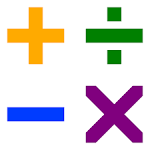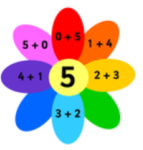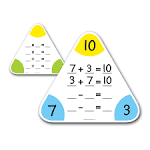Maths Policies
At Thorpe Primary School we want to create confident, skilful mathematicians who have a life-long love of mathematics and can expertly apply their knowledge and understanding.
The 2014 National Curriculum states:
“Mathematics is a creative and highly inter-connected discipline that has been developed over centuries, providing the solution to some of history’s most intriguing problems. It is essential to everyday life, critical to science, technology and engineering, and necessary for financial literacy and most forms of employment. A high-quality mathematics education therefore provides a foundation for understanding the world, the ability to reason mathematically, an appreciation of the beauty and power of mathematics, and a sense of enjoyment and curiosity about the subject.”
At Thorpe Primary School we use Power Maths to help develop a deeper understanding of mathematics through: fun practical activities, exploration, discussion, problem solving and reasoning.
Foundation Stage
In the Foundation Stage, the children follow the Early Years Foundation Stage Curriculum. They have the opportunity to explore, enjoy and learn about mathematics through play. They learn and develop mathematical concepts, understanding and vocabulary. In the Reception Year maths sessions are introduced using Power Maths as a basis for developing place value and number and the children engage in mental maths, practical tasks and activities linked to Number and Shape, space and measures.
Key Stage 1 and 2
From Year 1 to Year 5, the children are taught in class groups for mathematics lessons. The teacher then plans and delivers lessons based on the varying needs of those children, differentiating the work according to each child’s ability.
In Year 6, the children are set into maths groups and the teacher then plans and delivers lessons based on the needs of the children in each of those groupings.
Our curriculum covers the mathematical strands as set out in the Primary National Curriculum for Mathematics:
- Number and place value
- Number – addition and subtraction
- Number – multiplication and division
- Number – fractions (including decimals and percentages)
- Measurement
- Geometry – properties of shape
- Geometry – position and direction
- Statistics
- Ratio and proportion
- Algebra
Some of these areas of the curriculum are only expected to be taught in particular year groups.
Calculations
The Calculation Policy sets out the guidelines that teachers follow in the teaching addition, subtraction, multiplication, division and fractions, decimals and percentages. As the children progress in their learning throughout the school, they will learn new ways of solving problems using a range of different methods. The Calculation Policy shows a range of different methods and representations in order to give all children the opportunity to find a process that works best for them.
multiplication, division and fractions, decimals and percentages. As the children progress in their learning throughout the school, they will learn new ways of solving problems using a range of different methods. The Calculation Policy shows a range of different methods and representations in order to give all children the opportunity to find a process that works best for them.
Power Maths Lessons: Reception
Each week is part of a sequence of learning. The learning is built around a weekly structure, with each new step of learning introduced over the course of 5 lessons.
- Day 1: Weekly Starter- the focus of the week is introduced through songs, stories, photographs, pictures or games to prompt a practical activity.
- Day 2: Discover and Share- the children attempt a practical problem in a real-life context and share their ideas. The teacher works through a modelled answer using concrete, pictorial, abstract approach.
- Day 3: Think together and Practice- Whole-class guided practice opportunities. The Maths Journal provides the children with an opportunity for independent practice. Children draw, use concrete objects or talk through the problem to show their understanding.
- Day 4: Challenge and Strengthen- This deepens children’s understanding through either a challenge activity or a strengthening activity to support.
- Day 5: Practical Activities and Reflect- Practical activities that move children into more abstract maths such as activities that use sound and movement rather than visual clues. Children show the depth of their understanding in an open-ended reflection activity in the Maths Journal.
Power Maths Lessons: Y1-Y6
Each lesson is part of a sequence of learning. There are different elements, informed by research into best practice in maths teaching, that bring the lessons to life:
- Discover – each lesson begins with a problem to solve, often a real-life example, sometimes a puzzle or a game. These are engaging and fun, and designed to get all children thinking.
- Share – the class shares their ideas and compares different ways to solve the problem, explaining their reasoning with hands-on resources and drawings to make their ideas clear. Children are able to develop their understanding of the concept with input from the teacher.
- Think together – the next part of the lesson is a journey through the learning, digging deeper and deeper so that each child builds on secure foundations while being challenged to apply their understanding in different ways and with increasing independence following the format I do, we do, you do.
- Practice – now children practice individually or in small groups, rehearsing and developing their skills to build fluency, understanding of the concept and confidence.
- Reflect – finally, children are prompted to reflect on and record their learning from each session and show how they have grasped the concept explored in the lesson.
In order to develop the children’s understanding, we provide a mathematical toolbox for the children to access when they are working. These include such things as: tens frames, bead strings, number lines, 100 squares, hundreds, tens and units equipment, place value cards, dice, counters etc.
Number Bonds
 Secure knowledge of number bonds is an essential mathematical skill. As adults, we use number bonds all the time in our day-to-day life and secure knowledge of number bonds is vital when attempting harder calculations. At Thorpe, we teach number bonds in a variety of ways so that children are able to represent, use and “see” them independently in different applications.
Secure knowledge of number bonds is an essential mathematical skill. As adults, we use number bonds all the time in our day-to-day life and secure knowledge of number bonds is vital when attempting harder calculations. At Thorpe, we teach number bonds in a variety of ways so that children are able to represent, use and “see” them independently in different applications.
Number bonds are often shown through representations. We particularly like Numicon, as a physical resource, as it allows the children to manipulate the number tiles to make the total bond. Other pictorial resources used in school include: tens frames, dienes, counters, cubes and other objects. For more information on these please refer to the calculation policy.
We also encourage children to make the connection between “fact families” where the addition and subtraction  number sentences are linked. Moreover, it is useful to highlight the connection between number bonds to 10 with number bonds to 20 and to 100. For example,
number sentences are linked. Moreover, it is useful to highlight the connection between number bonds to 10 with number bonds to 20 and to 100. For example,
1 + 9 = 10 1 + 19 = 20 10 + 90 = 100
In Year 1, children are tested weekly on a range of different number bonds. We believe this supports the children learning their bonds and many children like the personal challenge that this brings.
How the system works:
- The are 3 tests for each number from 5- 20 , 50, 100 (multiples of 5, multiples of 10 , and mixed).
- Children will take the challenge each week.
- Children have one minute to complete the challenge (higher numbers have more questions than lower numbers).
- Once a child starts, they progress at their own speed – there is no year group expectation but nationally children are expected to know their bonds from 1-10 by the end of Key Stage 1 (Year 2).
- Children should be encouraged to learn the number bond they are working on as part of their homework.
- There will be a recording grid on the system so teachers can track each individual’s progress.
Times Tables
We understand that the ability to remember each times table is an important skill, which is applied across the mathematics curriculum, and children are expected to know certain times tables facts by the end of each year.
|
Year Group |
Tables children should know by the end of the year |
|
2 |
x2 table, x10 table, x5 table |
|
3 |
x3 table, x4 table, x8 table |
|
4 |
X6 table, x9 table, x7 table, x11 table, x12 table |
|
5/6 |
All tables should be now be completed |
At Thorpe Primary School, we aim to inspire and motivate children in learning their times tables by gaining certificates, bands and badges during the programme.
There are 3 stages to learning each times table:
Bronze: the children can recall the facts in order e.g. 2x1=2, 2x2=4, 2x3=6, 2x4=8 and so on
Silver: the children can recall the facts in any order e.g. 2x7=14, 2x3=6, 2x6=12 and so on
Gold: the children can recall the related division facts e.g. 18÷2 = 9, 6÷2=3, 12÷2=6 and so on.
Every week, each child will be tested on the table they are learning; when they have achieved 12/12 they move on to the next award. For each award your child will receive a certificate and when they complete the gold award they will also be given a wristband to help them learn the next times table.
When they complete all the tables, they are given a special times table champion badge to wear on their jumper.
The children will then complete the platinum tests for each times table, in which the children will be assessed on a mixture of the silver and gold awards for each times table. This will enable the children to continuously practice their times tables facts.
TT Rockstars
We use Times Tables Rock Stars for Years 3 to 6. It is an online platform where children can:
- Work on times tables that their teacher has set especially for them
- Improve speed
- Play against their friends and other children
Arithmetic
Children from Year 2 to Year 6 have regular arithmetic tests using all four operations and a range of numbers. The tests are then marked and feedback given to the children on how to answer particular questions with further practice included to help the children further develop their knowledge and understanding of particular areas of arithmetic.
Assessments
At Thorpe school, we use daily assessments, gap analysis from testing and individual targets to help every child to develop to his or her potential as learning must be aimed at individual children’s needs. Results and children’s targets are shared at parents’ evenings and throughout the year.
In Key Stage 1 and 2, termly summative assessments are carried out to identify gaps in learning, which are then addressed by the class teacher.
Staff monitor the children’s progress throughout the year through observations, marking work and feeding back to the children.
Intervention
To ensure all children reach their potential, where appropriate, we use a range of intervention strategies, including:
- Pre-teach and Post-teach
- Numicon
- 1st class @ number
Children in Key Stage 1 and 2 are given weekly homework tasks in mathematics that are linked to their current learning. There is homework support on the website which provides helpful information. There are also examples of Thorpe School’s calculation policy showing how we teach addition, subtraction, multiplication and division on the school website.
